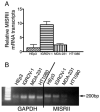Mullerian inhibiting substance inhibits invasion and migration of epithelial cancer cell lines
- PMID: 21056908
- PMCID: PMC3008816
- DOI: 10.1016/j.ygyno.2010.09.017
Mullerian inhibiting substance inhibits invasion and migration of epithelial cancer cell lines
Abstract
Objective: Given the fact that Mullerian Inhibiting Substance (MIS) causes complex remodeling of the urogenital ridge and regression of the Mullerian ducts during male embryonic development, we examined whether MIS could affect similar cell properties such as migration and invasion that could contribute ultimately to micro-metastasis of cancers arising from Mullerian tissues. MIS receptor expressing cell lines found to be invasive and migratory in vivo are examined in an in vivo assay that is cost-effective.
Methods: We designed in vitro and in vivo experiments to determine if MIS inhibited the movement of cancer lines IGROV-1, HEp3, MDA-MB-231, and HT1080 in cell culture invasion/migration chamber assays and in chick embryo metastasis assays.
Results: MIS, at concentrations below those that inhibit cell proliferation, blocked in vitro invasion and in vivo migration of epithelial cancer cells that express the MIS receptor.
Conclusions: While our laboratory has previously established MIS as an inhibitor of cancer cell proliferation using in vitro assays and in vivo xenografts, we now show that MIS can also inhibit in vivo tumor migration.
Copyright © 2010 Elsevier Inc. All rights reserved.
Conflict of interest statement
Figures




Similar articles
-
Mullerian Inhibiting Substance enhances subclinical doses of chemotherapeutic agents to inhibit human and mouse ovarian cancer.Proc Natl Acad Sci U S A. 2006 Nov 14;103(46):17426-31. doi: 10.1073/pnas.0607959103. Epub 2006 Nov 6. Proc Natl Acad Sci U S A. 2006. PMID: 17088539 Free PMC article.
-
Recombinant human Mullerian inhibiting substance inhibits long-term growth of MIS type II receptor-directed transgenic mouse ovarian cancers in vivo.Clin Cancer Res. 2006 Mar 1;12(5):1593-8. doi: 10.1158/1078-0432.CCR-05-2108. Clin Cancer Res. 2006. PMID: 16533786
-
Enhanced purification and production of Müllerian inhibiting substance for therapeutic applications.Mol Cell Endocrinol. 2003 Dec 15;211(1-2):37-42. doi: 10.1016/j.mce.2003.09.009. Mol Cell Endocrinol. 2003. PMID: 14656474 Review.
-
Identification of characteristic molecular signature of Müllerian inhibiting substance in human HPV-related cervical cancer cells.Int J Oncol. 2011 Oct;39(4):811-20. doi: 10.3892/ijo.2011.1042. Epub 2011 May 13. Int J Oncol. 2011. PMID: 21573503 Free PMC article.
-
Müllerian inhibiting substance/anti-Müllerian hormone: A novel treatment for gynecologic tumors.Obstet Gynecol Sci. 2014 Sep;57(5):343-57. doi: 10.5468/ogs.2014.57.5.343. Epub 2014 Sep 17. Obstet Gynecol Sci. 2014. PMID: 25264524 Free PMC article. Review.
Cited by
-
Chick chorioallantoic membrane (CAM) assay as an in vivo model to study the effect of newly identified molecules on ovarian cancer invasion and metastasis.Int J Mol Sci. 2012;13(8):9959-9970. doi: 10.3390/ijms13089959. Epub 2012 Aug 10. Int J Mol Sci. 2012. PMID: 22949841 Free PMC article.
-
Anti-Müllerian hormone and risk of ovarian cancer in nine cohorts.Int J Cancer. 2018 Jan 15;142(2):262-270. doi: 10.1002/ijc.31058. Epub 2017 Oct 4. Int J Cancer. 2018. PMID: 28921520 Free PMC article.
-
Reduced serum levels of anti-Müllerian hormone in females with inherited bone marrow failure syndromes.J Clin Endocrinol Metab. 2015 Feb;100(2):E197-203. doi: 10.1210/jc.2014-2838. Epub 2014 Nov 18. J Clin Endocrinol Metab. 2015. PMID: 25405500 Free PMC article.
-
Translational Physiology of Anti-Müllerian Hormone: Clinical Applications in Female Fertility Preservation and Cancer Treatment.Front Endocrinol (Lausanne). 2021 Sep 7;12:689532. doi: 10.3389/fendo.2021.689532. eCollection 2021. Front Endocrinol (Lausanne). 2021. PMID: 34557157 Free PMC article. Review.
-
The humanized anti-human AMHRII mAb 3C23K exerts an anti-tumor activity against human ovarian cancer through tumor-associated macrophages.Oncotarget. 2017 Oct 7;8(59):99950-99965. doi: 10.18632/oncotarget.21556. eCollection 2017 Nov 21. Oncotarget. 2017. PMID: 29245952 Free PMC article.
References
-
- Masiakos PT, MacLaughlin DT, Maheswaran S, Teixeira J, Fuller AF, Jr, Shah PC, et al. Human ovarian cancer, cell lines, and primary ascites cells express the human Mullerian Inhibiting Substance (MIS) type II receptor, bind, and are responsive to MIS. Clin Cancer Res. 1999;7:3488–99. - PubMed
-
- Segev DL, Ha TU, Tran TT, Kennealy M, Harkin P, Jung M, et al. Mullerian Inhibiting Substance inhibits breast cancer cell growth through an NFkappa B-mediated pathway. J Biol Chem. 2000;275:28371–9. - PubMed
-
- Teixeira J, Maheswaran S, Donahoe PK. Mullerian Inhibiting Substance: an instructive developmental hormone with diagnostic and possible therapeutic applications. Endocr Rev. 2001;22:657–74. - PubMed
Publication types
MeSH terms
Substances
Grants and funding
LinkOut - more resources
Full Text Sources
Miscellaneous

